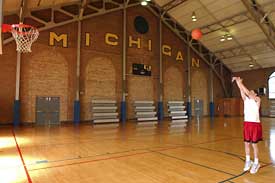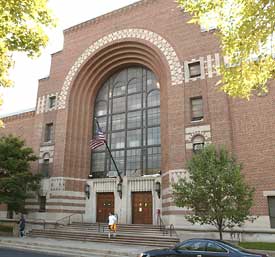Longtime Director of Recreational Sports Mike Stevenson came to U-M in 1970 to assist in the University’s growing intramural and recreational sports program. He found his way to the right place—the Intramural Sports Building (IMSB)—and immediately was awed by his surroundings.

“I walked into that building and the beauty of the lobby just struck me. I thought, ‘this is a special place,'” says Stevenson, now the executive associate athletic director for the Department of Intercollegiate Athletics. “Walking in there, you think, I am in an art museum, not a sports facility.'”
Flanked by its Athletic Department neighbors Cliff Keen Arena to the east and the Canham Natatorium to the west—all three together guarding the north edge of the athletic campus—the IMSB is evolving while celebrating a storied past marked this fall by its 75th anniversary.
Completed in 1928, the IMSB is undergoing renovations by next fall that will include expansion of the weight room and creation of a new 8,000-square-foot cardiovascular and weight center. But with all of the sawdust flying at 606 E. Hoover St., the building remains largely intact.
“It is a credit to the building directors and the University for taking pride in one of its beautiful old ladies,” says Bill Canning, director of recreational sports since 1999. “We have had to be very careful, and will always be very careful, that any renovations we do there keep the integrity of the historical nature of the facility.”

Both Stevenson and Canning credit Elmer Mitchell, known as the father of intramural sports, for creating the facility with the goal of providing a place for athletics for every student on campus. Mitchell’s vision will be among the ideas celebrated Oct. 17-18 when the Department of Recreational Sports hosts several anniversary events.
The weekend begins Oct. 17 with a free tour of the building 2-4 p.m. At 4:30 p.m., Sigma Alpha Epsilon ’61 will face the Campus All-Stars at nearby Elbel Field in a recreation of the of the 1961 Intramural Flag Football Championship. The day concludes with an open house 7-9 p.m., featuring tours, food, a silent auction and historical displays.
Prior to the Oct. 18 Homecoming football game against Illinois, Rec Sports will host tours 9-11 a.m. The front and rear entrances to the IMSB will be open to coincide with the Alumni Tailgate at the adjacent outdoor track. A reception will follow the game 3:30-5 p.m., followed by a recognition ceremony from 5-6 p.m.
History will be on display all weekend, from the original hardwood floors in the basketball gymnasium to the original marble still holding its water in the swimming pool. Many areas have been renovated to make room for new programs.
Everything typically found in recreational facilities today, with the exception of a suspended track that the building doesn’t have room for, was in the IMSB in 1928, Stevenson says. “The true character of that building is not going to change. I think in 75 years, it will still be standing and used as it is now,” he says.
Intercollegiate Athletics oversees the building and Rec Sports. The IMSB lost a tenant when the men’s gymnastics team moved to the Sports Coliseum last year, but the space was converted to an indoor practice facility for the women’s varsity crew team and the men’s club varsity squad.
“The actual spaces and activities areas have been functional for 75 years, and that speaks for itself,” Canning says. “When you think of 25 million pairs of gym shoes running around that facility over the years, that is a lot of wear-and-tear. For its functionality, the IMSB still stands up against any facility.”
Canning says usage patterns have changed since the 1960s, when he served as a building supervisor. More than 2,000 faculty, staff and students use the IMSB daily, he says, and it gets significant use as home for many of Rec Sports’ intramural sports activities. Today, he says, participants utilize exercise equipment and free weights to augment their sports activities.
“Back when I started in recreation, runners were runners, swimmers were swimmers, and basketball players were basketball players,” Canning says, adding that U-M needs 1.25 square feet of weight and fitness space for every student on campus. “You were just that, or you were a weightlifter.”
Canning, associate director of Rec Sports from 1976-85, says the original IMSB design did not have a weight room. He says all the squash courts and some racquetball rooms have been removed to make way for more free weights, equipment and a new climbing wall.
“The walls really have stood the test of time,” says Canning, estimating that 75 percent of U-M students use Recreational Sports facilities annually and one-third of them frequent the IMSB. “It has a great history, and we are renovating it to better serve the population.”

